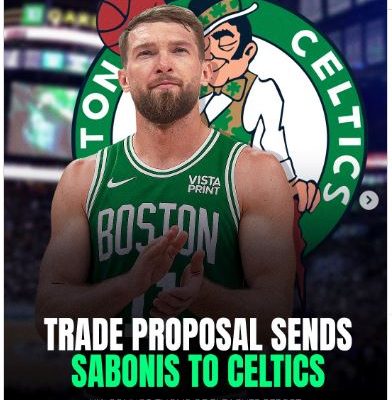In a move that’s sending shockwaves across the NBA landscape and reshaping the Eastern Conference title picture, the Boston Celtics have officially acquired a game-changing force in the frontcourt. The Celtics have completed a trade for Sacramento Kings’ dominant big man, a three-time All-Star who is coming off one of the most productive seasons of his career, averaging 19.1 points, 13.9 rebounds, and six assists per game while shooting an efficient 59 percent from the field. It’s a significant, high-stakes acquisition that underscores Boston’s full-throttle championship ambitions and adds an elite level of talent to an already dangerous roster.
This trade doesn’t just move the needle—it obliterates the status quo in Boston. After months of speculation about whether the Celtics would stand pat or make a major move to bolster their roster, the front office has decisively opted for the latter. The addition of a versatile, high-IQ big man with a proven résumé completely redefines the Celtics’ offensive and defensive approach. His ability to stretch the floor, pass from the high post, and dominate the glass gives Boston a layer of versatility that few frontcourts in the league can match. More importantly, it addresses a glaring need that has hovered over this team for the past few seasons: consistent production and dynamism at the center position.
For years, the Celtics have attempted to patch together a paint presence using a committee approach. Luka Garza, Neemias Queta, and Xavier Tillman all have provided flashes of brilliance and energy at different times, but none of them possess the full package that this All-Star brings to the table. Garza offers toughness and rebounding but is limited defensively against quicker bigs. Queta has length and upside but still struggles with consistency in big moments. Tillman provides grit and effort, yet lacks the offensive creativity and playmaking to truly tilt games. Now, Boston adds a player who not only elevates the floor of the position but raises the ceiling of the entire roster.
This new centerpiece doesn’t just finish plays—he initiates them. With the ability to grab a rebound and immediately push the ball up the court, he’ll serve as a secondary playmaker who can take pressure off the Celtics’ backcourt stars. Imagine Jayson Tatum and Jaylen Brown cutting off-ball while their new teammate surveys the floor from the elbow, capable of whipping cross-court passes or delivering bounce passes to cutters in stride. It’s a wrinkle Boston hasn’t had consistently since the days of Al Horford in his prime, and even then, this new arrival brings a level of athleticism and rebounding that few centers in the league can match.
The ramifications of this trade extend beyond just talent acquisition—it’s a philosophical statement. The Celtics are not just aiming to compete for a title; they’re making it clear that they expect to win one now. This is not a development project or a gamble on potential. This is a fully formed All-Star who fits perfectly into the modern NBA. His passing, spacing, and shot-making from mid-range and inside ten feet give the Celtics a go-to option in the half-court offense when the perimeter dries up. His presence ensures that Boston’s spacing will remain elite, even if defenses overcommit to shutting down the wings.
From a defensive standpoint, the Celtics get a rebounding monster who can anchor the paint, switch onto wings when needed, and guard pick-and-rolls with intelligence and poise. His frame and instincts make him a difficult player to move off his spot, and he has the quickness to recover and contest shots even when drawn out of position. For a Boston team that prides itself on defensive identity, adding a player who can both protect the rim and defend in space is an ideal fit.
This deal also comes with implications for the Celtics’ rotation and cap sheet. Boston likely gave up some combination of draft assets and rotational players to facilitate the trade, but given the caliber of the incoming player, it’s a price the front office was more than willing to pay. The team has operated under the guiding principle that windows in the NBA are fleeting, and championship-level opportunities must be seized without hesitation. The Celtics have often been accused of hoarding assets, of being too calculated when boldness was required. Not this time. They struck while the iron was hot, and their reward is a foundational piece who complements their core perfectly.
Locker room dynamics also play a role in trades of this magnitude, and early indications suggest that this All-Star big man is not just respected across the league, but beloved by teammates. His unselfish nature, vocal leadership, and blue-collar approach should translate seamlessly into Boston’s team-first culture. Veterans like Al Horford and Jrue Holiday will likely relish having another seasoned professional on board, while younger players will benefit from the example set by someone who’s made multiple All-Star appearances through a relentless work ethic.
Meanwhile, on the Kings’ side, this trade marks the end of an era. It’s a signal that Sacramento is ready to pivot toward a different core or prioritize flexibility and youth moving forward. Despite the player’s stellar individual numbers, the Kings may have felt their ceiling was capped and opted to move now before risking diminishing returns. Sacramento’s willingness to part with such a high-caliber player also hints at larger structural concerns or perhaps a desire to reallocate salary cap space in a more balanced fashion. Nevertheless, the loss is significant, and it remains to be seen whether the Kings can maintain their competitive edge in the fiercely contested Western Conference.
Boston, however, is not interested in patience or hypothetical upside. They are all-in, and with good reason. Their core of Tatum, Brown, Holiday, Derrick White, and now their newly acquired big man, forms one of the most complete starting fives in basketball. Each player brings elite skills on both ends of the court, and each is capable of carrying the team through different phases of a playoff run. The bench, already bolstered by consistent contributors and savvy depth pieces, now gets the benefit of more balanced rotations and defined roles.
It’s also worth noting the psychological impact this trade will have on the rest of the league. Teams that were eyeing Boston as a beatable contender may now be forced to reassess. A frontcourt of this caliber neutralizes some of the league’s most dominant bigs while giving Boston a counterpunch that’s been missing since the departure of Kevin Garnett. For opponents, the path to the Finals just became significantly more complicated.
In the days to come, analysts will dissect the X’s and O’s, and pundits will debate whether the Celtics paid too much or whether the new addition can stay healthy through an 82-game grind. But for now, one thing is abundantly clear: the Boston Celtics just made a statement that they are not waiting for the future to arrive—they’re reaching out and grabbing it by the throat. This trade changes everything. The league has been put on notice. The road to the NBA championship just got a whole lot greener.



